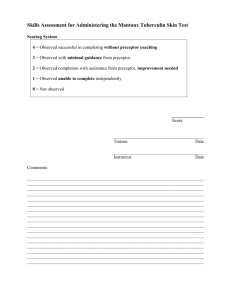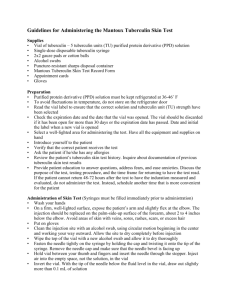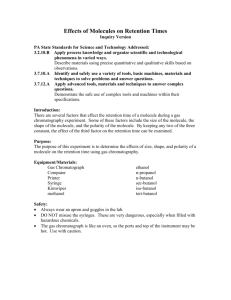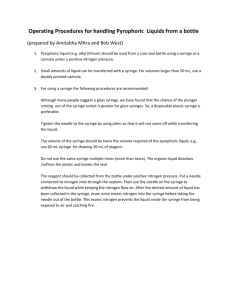Матрикул_engl_stomat
advertisement
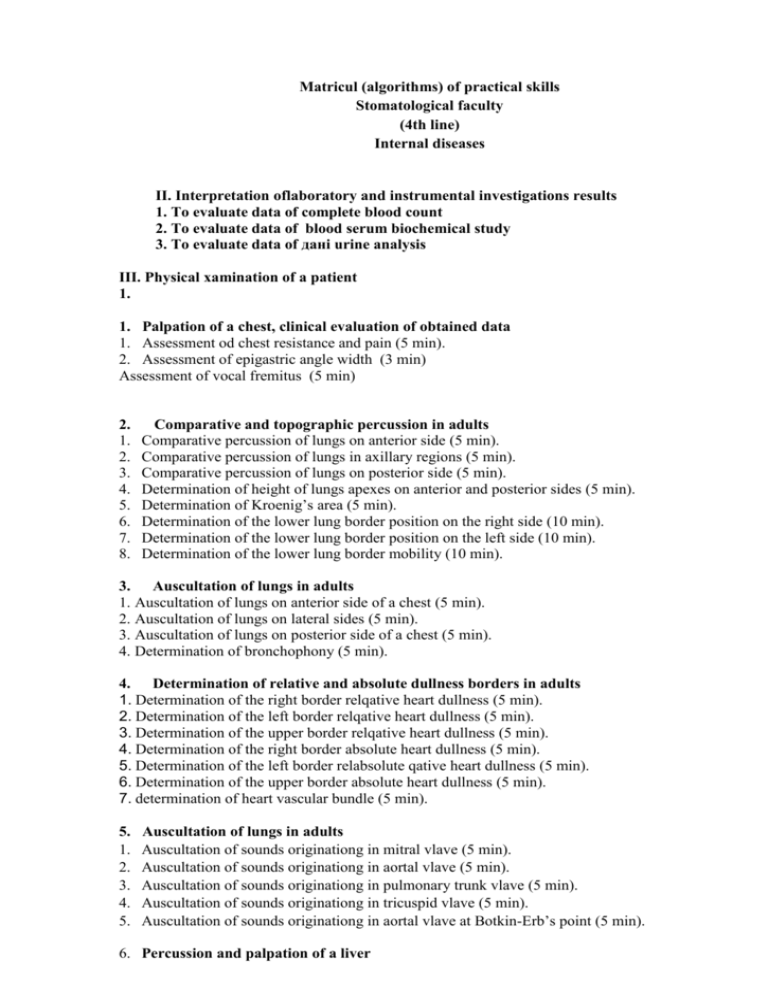
Matricul (algorithms) of practical skills Stomatological faculty (4th line) Internal diseases ІІ. Interpretation oflaboratory and instrumental investigations results 1. To evaluate data of complete blood count 2. To evaluate data of blood serum biochemical study 3. To evaluate data of дані urine analysis III. Physical xamination of a patient 1. 1. Palpation of a chest, clinical evaluation of obtained data 1. Assessment od chest resistance and pain (5 min). 2. Assessment of epigastric angle width (3 min) Assessment of vocal fremitus (5 min) 2. 1. 2. 3. 4. 5. 6. 7. 8. Comparative and topographic percussion in adults Comparative percussion of lungs on anterior side (5 min). Comparative percussion of lungs in axillary regions (5 min). Comparative percussion of lungs on posterior side (5 min). Determination of height of lungs apexes on anterior and posterior sides (5 min). Determination of Kroenig’s area (5 min). Determination of the lower lung border position on the right side (10 min). Determination of the lower lung border position on the left side (10 min). Determination of the lower lung border mobility (10 min). 3. Аuscultation of lungs in adults 1. Auscultation of lungs on anterior side of a chest (5 min). 2. Auscultation of lungs on lateral sides (5 min). 3. Auscultation of lungs on posterior side of a chest (5 min). 4. Determination of bronchophony (5 min). 4. Determination of relative and absolute dullness borders in adults 1. Determination of the right border relqative heart dullness (5 min). 2. Determination of the left border relqative heart dullness (5 min). 3. Determination of the upper border relqative heart dullness (5 min). 4. Determination of the right border absolute heart dullness (5 min). 5. Determination of the left border relabsolute qative heart dullness (5 min). 6. Determination of the upper border absolute heart dullness (5 min). 7. determination of heart vascular bundle (5 min). 5. 1. 2. 3. 4. 5. Auscultation of lungs in adults Auscultation of sounds originationg in mitral vlave (5 min). Auscultation of sounds originationg in aortal vlave (5 min). Auscultation of sounds originationg in pulmonary trunk vlave (5 min). Auscultation of sounds originationg in tricuspid vlave (5 min). Auscultation of sounds originationg in aortal vlave at Botkin-Erb’s point (5 min). 6. Percussion and palpation of a liver 1. 2. 3. 4. 5. 6. Determination of the lower liver border on anterior axillary line on the right side (5 min). Determination of the lower liver border on midclavicular line on the right side (5 min). Determination of the lower liver border on the right parasternal line (5 min). Determination of the lower liver border on median line (5 min). Determination of liver sizes by Kurlov’s method (10 min). Palpation of lover liver border at the top of inspiration (5 min). 7. Palpation of a large colon by Obrastsov-Strazesko method in adults 1. Palpation of sigmoid colon, evaluation of results (5 min). 2. Palpation of caecum, evaluation of results (5 min). 3. Palpation of terminal part of ileum, evaluation of results (5 min). 4. Palpation of ascending colon, evaluation of results (5 min). 5. Palpation of descending colon, evaluation of results (5 min). 6. Palpation of transverse colon, evaluation of results (5 min). Spring semester Module 1. Basic duties and professional actions of a nurse of therapeutic department 1. Diffolving of antibiotics and other powdered drugs 2. Prepare the necessary equipment. 3. Check the label on a vial or ampoule with doctor’s prescription and time of usefulness. 4. Treat your hands and the cover of the vial with alcohol solution 5. Fill a syringe with any solvent taking into account that each 100 000 UN are to be dissolved in 1 ml of a solvent. 6. Remove the metallic cover of the vial with a forceps, puncture the rubber cork of a vial and to introduce slowly the solvent inside the vial, than shake the vial. 7. Attach a syringe to the needle, to put the vial with bottom upright and feel the syringe with necessary volume of the dissolved antibiotic according to the necessary dosage. 2. Performance of intradermal injection 1. Fill a syringe with prescribed medicine and remove the air. 2. Remove clothes from the internal surface of patient’s forearm 3. Treat twice the place of injection with cotton balls wetted with disinfectant solution. 4. Stretch the skin in the place of injection. 5. Take the syringe into the right arm with the needle cutting edge upward and parallel to the skin 6. Insert the needle into the skin between its layers in such a way that the cutting edge is covered by epidermis. 7. Introduce slowly some drops of preparation by pressing on the piston of the syringe with the left hand. 3. Performance of subcutaneous injection 1.Fill a syringe with prescribed medicine and remove the air. 2.Treat twice the place of injection with cotton balls wetted with a disinfectant solution. 3.Take the skin and subcutaneous fat tissue in the place of injection with your index and a thumb in such a way to make a skin fold. 4. Insert the needle into the basis of the fold with brisk movement under the angle 30-45°С on 2/3 of the needle length 5. Introduce slowly medical preparation by pressing on the piston of the syringe with the left hand. 6. Apply the cotton ball wetted with a disinfectant solution to the place of puncture with your left hand and remove the needle with a brisk movement. 4. Performance of intramuscular injection 1. Fill a syringe with prescribed medicine and remove the air. 2. Instruct the patient how to assume convenient position (the better position is to be lying with face directed downward or on a side. Ask the patient to remove clothes from the place of puncture. 3. Treat twice the place of injection with cotton balls wetted with a disinfectant solution. 4. Take a syringe into the right arm (in such a way that the index supports the piston, the small finger supports the needle cannula and other fingers - the syringe corpus). 5. Stretch the skin in the place of injection between the index and the thumb of your left hand. 6. Insert the needle with brisk movement perpendicular to the skin surface on 2/3 of the needle length. 7. Introduce slowly medical preparation by pressing on the piston of the syringe with the left hand. 8. Apply the cotton ball wetted with a disinfectant solution to the place of puncture with your left hand and remove the needle with a brisk movement. 5. Intravenous administration of medicines 1. Fill a syringe with prescribed medicine and remove the air. 2. To instruct the patient how to assume convenient position ( the better position is to be lying on a couch). To ask him to remove clothes from the place of puncture. 3. Put a small pillow under the patient’s elbow 4. Apply a rubber tourniquet on the patient’s arm upper of the cubital fossa. 5. Ask the patient to clench the fist and check the feeling of cubital veins with blood by palpation. 6. Treat twice the place of injection (cubital flexure) with cotton balls wetted with a disinfectant solution. 7. Take a syringe into the right arm (in such a way that the index supports the needle cannula, the small finger supports the piston and other fingers- the syringe corpus). 8. Pres the vein slightly stretching it between the index and the thumb of your left hand to decrease its mobility. 9. Prick the skin above the vein and carefully insert the needle inside the vein till the filling of empty space, than move the meddle somewhat deeply parallel to the vein. 10. Slightly pull the piston back: if blood appears in the syringe than the needle cutting edge is inside the vein. 11. Pull out the tourniquet with your left hand. 12. Introduce slowly medical preparation by pressing on the piston of the syringe with the left hand. Leave 0,5 - 1 ml of the solution in the syringe. 13. Apply the cotton ball wetted with a disinfectant solution on the place of puncture. 14. Remove the needle with a brisk movement. Module 2. Symptoms and syndromes in diseases of internal organs 1. To evaluate data of spirography 1.Determine the degree of violation of respiratory volumes from normal findings 2. .Determine the degree of violation of ventilatory fuction of lungs from normal findings 3. .Determine the degree of violation of bronchial patency 4. Make your conclusion.
